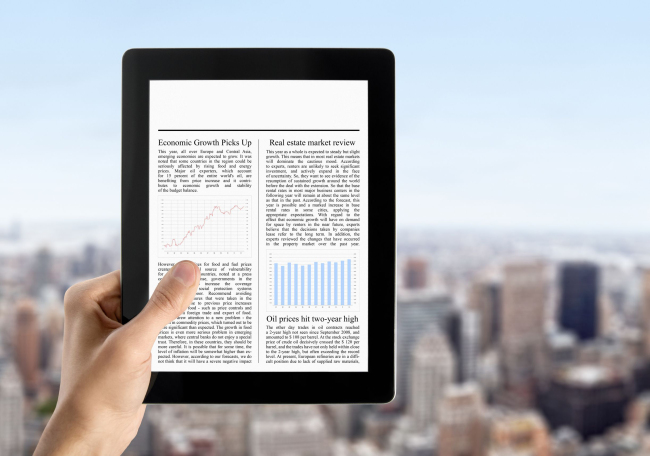The end of libraries? Sort of
Offline libraries trying to redefine their roles for the digital era
By Yoon Min-sikPublished : Nov. 8, 2013 - 21:06

Friendly librarians mill around towering bookshelves, with the smell of newly printed books and dusty paperbacks in the air. The traditional image of a library is of a place to study, read books and hang out at a leisurely pace.
With the emergence of the digital age, however, people are turning away from traditional libraries.
According to Statistics Korea, a Korean household spent an average of 19,026 won a month on books in 2012, down from 20,570 won the year before. It marked the first time since 2003 that the figure fell below 20,000 won.
Last year also saw the smallest number of newly published books in 12 years, at 86.9 million volumes.
The implication is ominous: People are reading far less than before. To cope with the harsh reality, Korean libraries are embracing digital platforms to win their old users back.
“Data from 2009 showed that out of seven major cities in South Korea, Incheon ranked last in the percentage of people who have read at least one book in a year, and fifth in total number of books that citizens read,” Son Myeong-Hee, an official from the Incheon Metropolitan City Library Association, told The Korea Herald.
“Incheon Metropolitan government recognized the problem with such poor reading habits, and launched the ‘Reading City Incheon’ project,” Son said.
The project is centered on the E-book Digital Library System, which provides Incheon citizens access to e-books anywhere, anytime. The e-book lending system works in two ways. Users can download the Reading City Incheon app to read e-books or they can find one of 23 “Smart Library” machines, swipe the QR code and “borrow” an e-book on their mobile devices.

While Incheon’s e-book lending system focuses on offering easy access to books, the state-run National Library of Korea emphasized the aspect of collecting and preserving information when establishing their own version of a digital library.
Since its opening in 2009, the digital library saw an increasing number of users each year, from 165,898 in 2009 to 217,640 last year. Its offline counterpart, on the other hand, had its ups and downs.
It is basically a digital version of the National Library of Korea, a repository of online and offline documents in South Korea. But it has the advantage as it allows users to find information with a few clicks. Another merit of the digital library is the three-dimensional images of ancient rare books, which anyone can access and are hardly ever made public in hard copy.
“We have digitized 97,256 of our 270,000 ancient books, some of which are kept away completely from the public eye, namely national treasures like Dongui Bogam,” said Cho Su-yeon, an official from the NLK’s public relations team. Dongui Bogam refers to a medical encyclopedia written by royal physician Heo Jun during the Joseon Dynasty.
While the NLK and IMLA turn analog content into digital format, Naver Library 1 is a perfect example of a company putting digital content into analog format.
Naver, the operator of Korea’s most-widely used Internet portal, opened the design and IT-themed facility in 2010. The physical library boasts some 24,000 books on IT and design from 29 countries, attracting tech-savvy readers.
Except for a few exceptions, the broader direction is toward digitalization. Professor Lee Jong-moon of the Department of Library and Information Science at Kyungsung University told The Korea Herald that the trend of digitization of libraries and books will quicken its pace in the future.
“For two reasons: It is economical and more convenient. E-books are easier to create and distribute, and are more accessible to readers because they can be read in a networked environment,” Lee said.
Despite the gloomy outlook, physical libraries will continue to function, he said. The key would be whether libraries can secure their expertise in filtering useful information and providing guidelines.
Many of the wooden shelves will be turned into digital bits and bytes, but libraries are likely to carry out important roles, only in a different fashion.
“From ancient times to modern society, libraries have always undergone restructuring. As paradigms (of reading) change, libraries will not fade away but will keep on changing themselves,” Lee said.
By Yoon Min-sik (minsikyoon@heraldcorp.com)
With the emergence of the digital age, however, people are turning away from traditional libraries.
According to Statistics Korea, a Korean household spent an average of 19,026 won a month on books in 2012, down from 20,570 won the year before. It marked the first time since 2003 that the figure fell below 20,000 won.
Last year also saw the smallest number of newly published books in 12 years, at 86.9 million volumes.
The implication is ominous: People are reading far less than before. To cope with the harsh reality, Korean libraries are embracing digital platforms to win their old users back.
“Data from 2009 showed that out of seven major cities in South Korea, Incheon ranked last in the percentage of people who have read at least one book in a year, and fifth in total number of books that citizens read,” Son Myeong-Hee, an official from the Incheon Metropolitan City Library Association, told The Korea Herald.
“Incheon Metropolitan government recognized the problem with such poor reading habits, and launched the ‘Reading City Incheon’ project,” Son said.
The project is centered on the E-book Digital Library System, which provides Incheon citizens access to e-books anywhere, anytime. The e-book lending system works in two ways. Users can download the Reading City Incheon app to read e-books or they can find one of 23 “Smart Library” machines, swipe the QR code and “borrow” an e-book on their mobile devices.

While Incheon’s e-book lending system focuses on offering easy access to books, the state-run National Library of Korea emphasized the aspect of collecting and preserving information when establishing their own version of a digital library.
Since its opening in 2009, the digital library saw an increasing number of users each year, from 165,898 in 2009 to 217,640 last year. Its offline counterpart, on the other hand, had its ups and downs.
It is basically a digital version of the National Library of Korea, a repository of online and offline documents in South Korea. But it has the advantage as it allows users to find information with a few clicks. Another merit of the digital library is the three-dimensional images of ancient rare books, which anyone can access and are hardly ever made public in hard copy.
“We have digitized 97,256 of our 270,000 ancient books, some of which are kept away completely from the public eye, namely national treasures like Dongui Bogam,” said Cho Su-yeon, an official from the NLK’s public relations team. Dongui Bogam refers to a medical encyclopedia written by royal physician Heo Jun during the Joseon Dynasty.
While the NLK and IMLA turn analog content into digital format, Naver Library 1 is a perfect example of a company putting digital content into analog format.
Naver, the operator of Korea’s most-widely used Internet portal, opened the design and IT-themed facility in 2010. The physical library boasts some 24,000 books on IT and design from 29 countries, attracting tech-savvy readers.
Except for a few exceptions, the broader direction is toward digitalization. Professor Lee Jong-moon of the Department of Library and Information Science at Kyungsung University told The Korea Herald that the trend of digitization of libraries and books will quicken its pace in the future.
“For two reasons: It is economical and more convenient. E-books are easier to create and distribute, and are more accessible to readers because they can be read in a networked environment,” Lee said.
Despite the gloomy outlook, physical libraries will continue to function, he said. The key would be whether libraries can secure their expertise in filtering useful information and providing guidelines.
Many of the wooden shelves will be turned into digital bits and bytes, but libraries are likely to carry out important roles, only in a different fashion.
“From ancient times to modern society, libraries have always undergone restructuring. As paradigms (of reading) change, libraries will not fade away but will keep on changing themselves,” Lee said.
By Yoon Min-sik (minsikyoon@heraldcorp.com)









![[Graphic News] More Koreans say they plan long-distance trips this year](http://res.heraldm.com/phpwas/restmb_idxmake.php?idx=644&simg=/content/image/2024/04/17/20240417050828_0.gif&u=)
![[KH Explains] Hyundai's full hybrid edge to pay off amid slow transition to pure EVs](http://res.heraldm.com/phpwas/restmb_idxmake.php?idx=644&simg=/content/image/2024/04/18/20240418050645_0.jpg&u=20240419100350)







![[KH Explains] Hyundai's full hybrid edge to pay off amid slow transition to pure EVs](http://res.heraldm.com/phpwas/restmb_idxmake.php?idx=652&simg=/content/image/2024/04/18/20240418050645_0.jpg&u=20240419100350)

